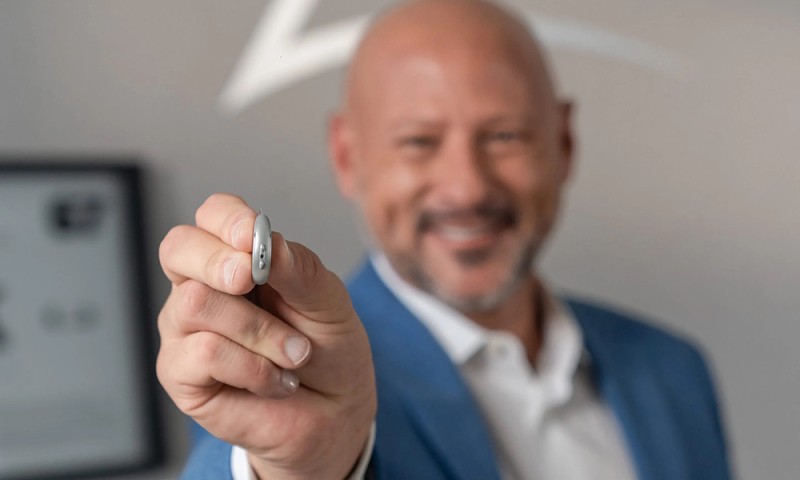
每当提及听力损失,人们往往会联想到祖父母将电视音量调到震天响,或与之交谈时不得不提高音量的情景。然而现实情况是,全球各年龄段听力损失人群已超15.7亿——仅在美国,听力损失就已成为第三大常见慢性病症,其发病率是糖尿病和癌症的两倍。
且情况预计将持续恶化:美国听力损失协会(Hearing Loss Association of America)预测,未来25年内,全球听力损失人群将突破25亿,几乎占全球总人口的三分之一。
市值达十亿美元的听力科技公司斯达克不仅致力于解决当下的听力损失问题,还在为日益突出的健康隐患提前布局。上周四,该公司发布了最新款助听器型号:Omega AI。
Omega AI是全球首款采用深度神经网络驱动定向技术与空间感知功能的助听器。深度神经网络是一种受人类大脑工作原理启发的机器学习系统,由多层节点构成,通过逐步处理数据实现信息传递。每个神经元接收信息、进行处理后传递至下一层,直至网络输出最终结果。斯达克听力健康首席官戴夫·法布里(Dave Fabry)向《财富》杂志透露,该助听器每小时可执行逾8000万次自动调节,以确保音质和言语清晰度达到最佳水平。
换言之,Omega AI能让用户更轻松地分辨环境中的各类声音——例如在刮风天散步时,用户希望能听清同行者的说话声,同时屏蔽背景噪音。
“我们有很多患者都真切期望这种功能可以在潜意识层面实现,”法布里说道,“他们希望借助人工智能的能力和算力,在安静和嘈杂环境等各种场景中,都能提升言语理解力。他们无需为了获得这些益处而过多地与设备进行交互。”这对那些可能因未知恐惧或技术认知不足而对使用人工智能心存顾虑的老年患者群体尤为友好。
更重要的是,Omega AI型号延续了斯达克将助听器打造成生活方式用品的使命。新款助听器通过My Starkey应用程序提供健康管理工具,包含提升身体平衡性与协调性的居家锻炼方案,以及业界首创的自动呼吸频率监测器。
“我们的工程师、科学家和听力学家正致力于提升音质表现,改善患者生活质量,”斯达克总裁兼首席执行官布兰登·萨瓦利奇(Brandon Sawalich)向《财富》杂志表示,“我们已开启智能听觉新时代,持续突破助听器的功能边界。”
斯达克如何融入可穿戴健康科技行业
倘若你是苹果的忠实粉丝,想必对该公司最新发布的AirPods系列感兴趣。AirPods Pro 3具备主动降噪、心率监测、健身追踪,甚至实时翻译功能。苹果此前宣称,AirPods可作为临床级助听器,适用于轻度至中度听力损失人群。
虽然从表面上看,这似乎对斯达克这类公司构成竞争,但萨瓦利奇解释道,大型科技公司认识到并接纳听力损失问题日益加剧的趋势,无疑是朝着正确方向迈出的重要一步。
“我欣喜于苹果对听力损失问题的关注,以及他们在AirPods上所做的努力,”萨瓦利奇说道,“人们需要明白,助听器和听力技术早已不再背负污名。”
但斯达克的独特优势在于开发出可长时间佩戴且更为隐蔽的产品。
“最有效的技术是那些能无缝融入生活、成为日常必备品的技术。”法布里表示。
尽管AirPods没有悬垂线缆,但其仍比斯达克助听器更为笨重。此外,其电池续航时间较短,使得听力损失较为严重的人群难以全天佩戴。
“我们必须设计、研发、制造并提供一款近乎隐形且支持每日长达14小时佩戴的产品,”萨瓦利奇表示,"我们必须打造用户佩戴舒适的产品。这既是契合生活方式的产品,也是提升生产力的工具,更是互联设备。"这款新产品还配备远程医疗功能,专业人士可远程调节助听器参数。助听器通过LED灯显示电池电量(行业领先的51小时续航),若监测到耳垢堆积情况会发出提示信号,若监测到用户跌倒会通知亲友,而且还具备防水功能。
萨瓦利奇还分享道,《创智赢家》明星戴蒙德·约翰(Daymond John,56岁)正在使用该产品,其搭档凯文·奥利里(Kevin O’Leary,71岁)也试用了斯达克的产品,因为“他们着眼于未来”,深谙斯达克产品的独特优势。
“我们看到他眼睛一亮,”萨瓦利奇谈及奥利里时说道,“他谈到如何借助斯达克产品提升日间工作效率。无论在片场休息还是等待拍摄,他都通过斯达克设备实时接收短信通知。”(*)
译者:中慧言-王芳
每当提及听力损失,人们往往会联想到祖父母将电视音量调到震天响,或与之交谈时不得不提高音量的情景。然而现实情况是,全球各年龄段听力损失人群已超15.7亿——仅在美国,听力损失就已成为第三大常见慢性病症,其发病率是糖尿病和癌症的两倍。
且情况预计将持续恶化:美国听力损失协会(Hearing Loss Association of America)预测,未来25年内,全球听力损失人群将突破25亿,几乎占全球总人口的三分之一。
市值达十亿美元的听力科技公司斯达克不仅致力于解决当下的听力损失问题,还在为日益突出的健康隐患提前布局。上周四,该公司发布了最新款助听器型号:Omega AI。
Omega AI是全球首款采用深度神经网络驱动定向技术与空间感知功能的助听器。深度神经网络是一种受人类大脑工作原理启发的机器学习系统,由多层节点构成,通过逐步处理数据实现信息传递。每个神经元接收信息、进行处理后传递至下一层,直至网络输出最终结果。斯达克听力健康首席官戴夫·法布里(Dave Fabry)向《财富》杂志透露,该助听器每小时可执行逾8000万次自动调节,以确保音质和言语清晰度达到最佳水平。
换言之,Omega AI能让用户更轻松地分辨环境中的各类声音——例如在刮风天散步时,用户希望能听清同行者的说话声,同时屏蔽背景噪音。
“我们有很多患者都真切期望这种功能可以在潜意识层面实现,”法布里说道,“他们希望借助人工智能的能力和算力,在安静和嘈杂环境等各种场景中,都能提升言语理解力。他们无需为了获得这些益处而过多地与设备进行交互。”这对那些可能因未知恐惧或技术认知不足而对使用人工智能心存顾虑的老年患者群体尤为友好。
更重要的是,Omega AI型号延续了斯达克将助听器打造成生活方式用品的使命。新款助听器通过My Starkey应用程序提供健康管理工具,包含提升身体平衡性与协调性的居家锻炼方案,以及业界首创的自动呼吸频率监测器。
“我们的工程师、科学家和听力学家正致力于提升音质表现,改善患者生活质量,”斯达克总裁兼首席执行官布兰登·萨瓦利奇(Brandon Sawalich)向《财富》杂志表示,“我们已开启智能听觉新时代,持续突破助听器的功能边界。”
斯达克如何融入可穿戴健康科技行业
倘若你是苹果的忠实粉丝,想必对该公司最新发布的AirPods系列感兴趣。AirPods Pro 3具备主动降噪、心率监测、健身追踪,甚至实时翻译功能。苹果此前宣称,AirPods可作为临床级助听器,适用于轻度至中度听力损失人群。
虽然从表面上看,这似乎对斯达克这类公司构成竞争,但萨瓦利奇解释道,大型科技公司认识到并接纳听力损失问题日益加剧的趋势,无疑是朝着正确方向迈出的重要一步。
“我欣喜于苹果对听力损失问题的关注,以及他们在AirPods上所做的努力,”萨瓦利奇说道,“人们需要明白,助听器和听力技术早已不再背负污名。”
但斯达克的独特优势在于开发出可长时间佩戴且更为隐蔽的产品。
“最有效的技术是那些能无缝融入生活、成为日常必备品的技术。”法布里表示。
尽管AirPods没有悬垂线缆,但其仍比斯达克助听器更为笨重。此外,其电池续航时间较短,使得听力损失较为严重的人群难以全天佩戴。
“我们必须设计、研发、制造并提供一款近乎隐形且支持每日长达14小时佩戴的产品,”萨瓦利奇表示,"我们必须打造用户佩戴舒适的产品。这既是契合生活方式的产品,也是提升生产力的工具,更是互联设备。"这款新产品还配备远程医疗功能,专业人士可远程调节助听器参数。助听器通过LED灯显示电池电量(行业领先的51小时续航),若监测到耳垢堆积情况会发出提示信号,若监测到用户跌倒会通知亲友,而且还具备防水功能。
萨瓦利奇还分享道,《创智赢家》明星戴蒙德·约翰(Daymond John,56岁)正在使用该产品,其搭档凯文·奥利里(Kevin O’Leary,71岁)也试用了斯达克的产品,因为“他们着眼于未来”,深谙斯达克产品的独特优势。
“我们看到他眼睛一亮,”萨瓦利奇谈及奥利里时说道,“他谈到如何借助斯达克产品提升日间工作效率。无论在片场休息还是等待拍摄,他都通过斯达克设备实时接收短信通知。”(*)
译者:中慧言-王芳
When you think about hearing loss, you might typically envision your grandparents blaring the television or having to semi-shout when talking to them. But the reality is more than 1.57 billion people of all ages worldwide experience hearing loss, which is the third-most common chronic physical condition in the U.S. alone, twice as prevalent as diabetes and cancer.
And it’s only expected to get worse: The Hearing Loss Association of America predicts in the next 25 years, more than 2.5 billion people worldwide will experience hearing loss. That’s nearly one-third of the world’s entire population.
Starkey, a billion-dollar hearing tech company, is one company addressing not only hearing loss today, but preparing for what is becoming only a more prominent health concern. On Thursday, the company announced its latest hearing aid model: Omega AI.
Omega AI is the first hearing aid in the world to use deep neural network-powered directionality and spatial awareness features. Deep neural networks are a type of machine learning system inspired by how the human brain works, consisting of multiple layers of nodes that process data step-by-step. Each neuron takes in information, processes it, and passes it to the next layer until the network produces a final output. The hearing aids make more than 80 million automatic adjustments per hour to ensure maximum sound quality and speech clarity, Dave Fabry, Starkey’s chief hearing health officer, told Fortune.
In other words, the Omega AI model makes it easier for users to differentiate sounds in their environment, say, if a user was taking a walk on a windy day and wanted to be able to tune into their walking partner’s voice and tune out the background noise.
“We have [many patients] who really just want this to occur at a subconscious level,” Fabry said. “They want to have all of the power of AI and computational power, the ability to improve speech understanding, in quiet and noise and all of those situations. But they don’t have to engage with the devices any more than necessary in order to get the benefit.” That makes it much easier for older-generation patients who may be apprehensive to use AI out of the fear of the unknown or not understanding the technology.
But more than that, the Omega AI model builds on Starkey’s mission to make their hearing aids more of a lifestyle device. The new model includes health-focused tools accessible through the My Starkey app that offer users at-home exercises to improve stability and coordination, as well as an industry-first automatic respiratory rate monitor.
“Our engineers and scientists and audiologists are looking at what we can do for sound quality, improve patients’ lives,” Brandon Sawalich, president and CEO of Starkey, told Fortune. “We’ve ushered in a new era of intelligent hearing. We keep pushing the boundaries of what hearing aids can be.”
How Starkey fits in the wearable health tech industry
If you’re an Apple fanatic, you likely were intrigued by the company’s latest AirPods launch. The AirPods Pro 3 offer active noise cancellation, heart-rate sensing, fitness tracking, and even live translation. Apple has also claimed in the past AirPods can act as a clinical-grade hearing aid for mild-to-moderate hearing loss.
And while at face-value that might feel like competition for a company like Starkey, Sawalich explained it’s a step in the right direction that large tech companies are recognizing and embracing the trend of increased hearing loss.
“I love that Apple is bringing attention to hearing loss and what they’re doing with AirPods,” Sawalich said. “People need to understand that there is no more stigma around hearing aids and hearing technology.”
But what sets Starkey apart is developing a product that can be worn for more hours of the day and something that’s more discreet.
“The most effective technologies are those that just seamlessly integrate into a person’s life, that become a part of their day-to-day existence,” Fabry said.
While AirPods, of course, don’t include dangling cords, they’re still more cumbersome than Starkey hearing aids. Plus, the battery life isn’t as long, which makes it difficult for people with more significant hearing loss to wear them throughout the day.
“We have to design, engineer, manufacture, and provide a product that is nearly invisible and is also designed for 14 hours a day,” Sawalich said. “We have to design a product that people are comfortable wearing. It’s a lifestyle product, it’s a productivity product, it’s a connectivity product.” The new product also includes a telehealth feature in which professionals can remotely make adjustments to the hearing-aid settings. The hearing aids will also indicate battery life (an industry-leading 51 hours) through LED lights, signal if there’s wax buildup, alert loved ones if it detects a fall, and is waterproof.
Sawalich also shared that Shark Tank star Daymond John, 56, wears the product, and his co-star Kevin O’Leary, 71, tried the Starkey products because “they live in the future” and understand what differentiates their products from others.
“We saw his eyes light up,” Sawalich said of O’Leary. “He was talking about how he uses Starkey products for his productivity during the day. If he’s sitting on a set or waiting for filming, he’s here listening to his text messages through the Starkey devices.”

